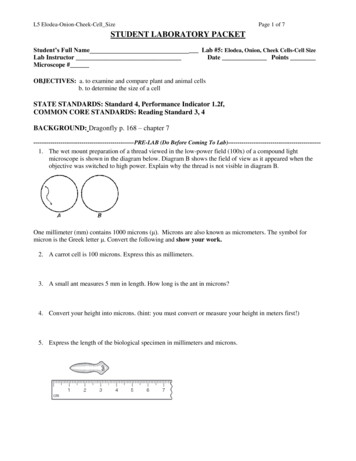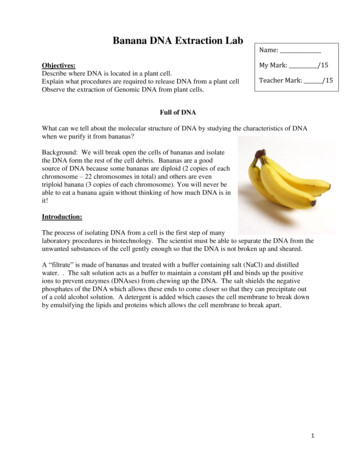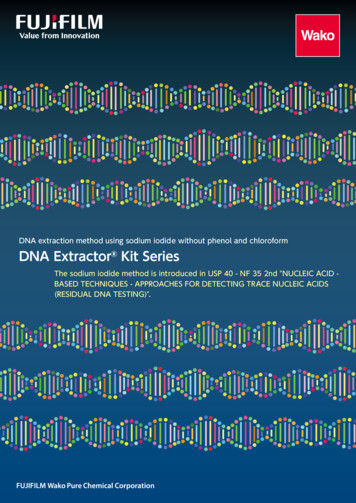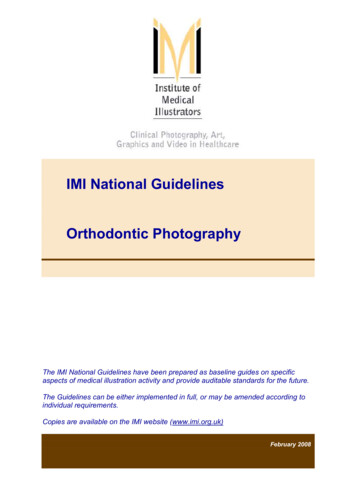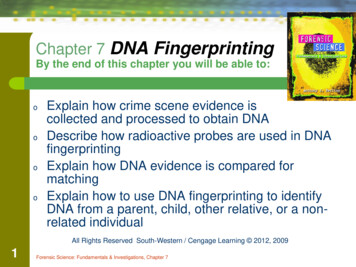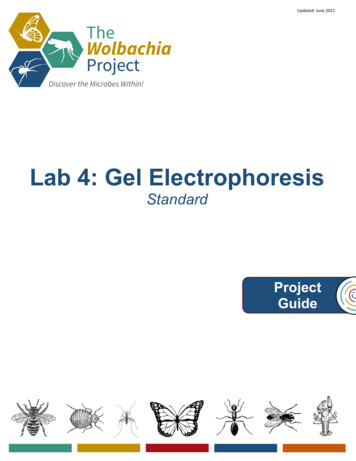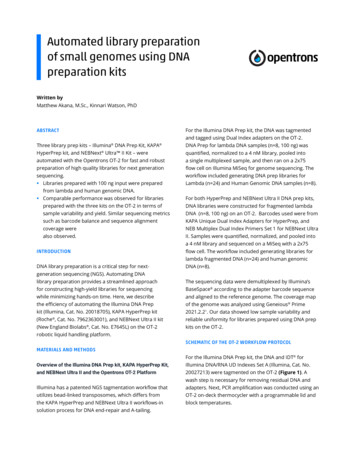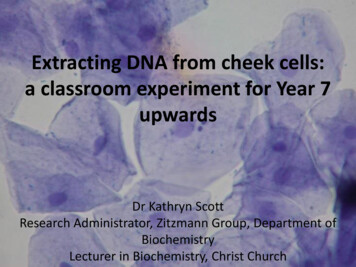
Transcription
Extracting DNA from cheek cells:a classroom experiment for Year 7upwardsDr Kathryn ScottResearch Administrator, Zitzmann Group, Department ofBiochemistryLecturer in Biochemistry, Christ Church
Extracting Human DNA in the Classroom Buccal (cheek cells) can be harvested painlessly andin sufficient quantity to visualise DNA extracted in asimple 4-step protocol We will be carrying out an optimised DNAextraction and discussing ‘kitchen chemistry’alternatives to the materials used DNA extraction based on:R.P. Hearn & K.E. Arblaster. DNA Extraction Techniques forUse in Education (2010) Biochem Mol Biol Edu 38(3) 161166 Original optimised protocol requires a centrifugationstep
The Steps in DNA Extraction1. Cell Harvesting3. Protein Digestion2. Cell Lysis4. DNA Precipitation
Objectives Basic level students will Know that DNA is found in the nucleus of cells Learn how to extract DNA from cells and describe thepurpose of the key steps of cell lysis, proteindegradation and DNA precipitation Observe the appearance of human DNA More advanced students will also Learn why buccal cells are a good choice for thisexperiment Understand the role of SDS and EDTA in cell lysis Understand the role of salt and alcohol in DNAprecipitation
Risk Assessment Biological samples should only be handled by the personfrom whom they are taken Lysis buffer is an emetic and may cause irritation if incontact with skin or eyes Protease solution may cause irritation if in contact with skinor eyes Isopropyl alcohol is toxic if consumed and if absorbedthrough the skin
Step 1 – Cell Harvesting
Step 1 – Harvesting Cells Pipette 3 ml water into your drinking cup Gently chew the inside of your mouth for 30 seconds Gently – blood doesn’t help Take the water from your tube into your mouth and move itaround for 30 seconds Don’t swallow the water Carefully spit the water back into your cup
Step 2 – Cell Lysis
Step 2 – Cell Lysis Add 2 ml of lysis buffer to the test tube you will be using forDNA extraction Pour the contents of your cup into the test tube Put the cap on your tube Gently swirl the tube to mix Shaking shears the DNA leading to short strands at theend of the experiment
Step 3 – Protein Digestion
Step 3 – Protein Digestion Add 0.25 ml ( 5 drops) of Proteinase K solution to the tube Adding an excess does not cause any problems Put the cap on your tube Gently swirl the tube to mix Place your tube in the 56oC water bath for 10 minutes
Buccal Cells Provide An Excellent Source of DNAStratified squamousnon-keratinizedepitheliumConnective tissue50 mm
Buccal Cells Provide An Excellent Source of DNA50 mm
Cell Lysis Buffer 50 mM Tris pH 8.0 Buffering for DNA stability and optimal enzyme activity 1 % Sodium dodecyl sulfate (SDS) 1 mM Ethylenediaminetetraacetic acid
Cell Lysis – The Structure of SDS (SDS)Computersimulation of aSodium DodecylSulfateMicelleMicelleCross-section
The Structure of Cell MembraneshydrophilichydrophobicThe lipid 1-palmityl-2-oleoylphosphatidylcholine(POPC)Cross section from acomputer simulation of apure POPC bilayer
SDS Disrupts Cell Membranes SDSmicelleLipidbilayerMixedmicelleA concentration of 0.3% - 1% SDS is sufficient to disrupt the membranesof buccal cells
Cell Lysis – What Does EDTA Do?Ethylenediaminetetraacetic Acid
EDTA Inhibits Enzymes such as DNase IDNACa2 Mg2 DNase IfrombovinepancreasBoth Ca2 and Mg2 are essentialfor DNase I functionDNase enzymes are found in most cells
Discussion Point Given that the lysis buffer is very similar incomposition to shampoo, why does shampoo notlyse our skin cellsStratified squamouskeratinizedepitheliumThe skin has a protective layerknown as the Stratum Corneum.The Stratum Corneum consistsof cells that have have lost theirnuclei, are embedded in a lipidmatrix and are enriched inkeratin proteins."Epidermal layers" by Mikael Häggström, based on work by Wbensmith File:WVSOM Meissner's corpuslce.JPG at Wikimedia commons
Discussion PointKeratinized epithelial (skincells) stained to visualise theDNA (green) and keratinfilaments (red)Note – these cells are fromthe lower epithelial layersKeratin has several importantroles Strengthens Cells Acts like a molecularsponge absorbing water ifskin is immersed in waterfor a long lialcells.jpg
Proteinase K Digestion Many proteins precipitate under the sameconditions as DNA If we digest the proteins into amino acids then only DNAwill precipitateProtein digestion also removes the histone ‘cotton reels’ around which the DNA is wrapped
Proteinase K Digestion Originally extracted from the fungus Tritirachium album Named due to its ability to cleave Keratin Many proteinases only cleave after a specific aminoacid This leads to the production of large fragments Proteinase K is relatively non-specific, therefore leaving verysmall fragments Is active over a wide range of temperatures Is active in the presence of a wide range of additivesincluding SDS EDTA
Step 4 – DNA Precipitation
Step 4 – DNA Precipitation Add 0.5 ml ( 10 drops) of 0.5 M NaCl to your tube Swirl your tube gently to mix Hold your tube at 45o and carefully pour in 10 ml of coldisopropyl alcohol Leave the tube on the desk for 5 minutes It is very important not to shake the tube After 5 minutes DNA should have precipitated at theinterface between the lysis buffer and the alcohol Swirling so that a vortex forms can aid precipitation Do not shake or invert the tube
DNA Precipitation DNA is a highly polar moleculeThere is a negatively chargedphosphate group joiningevery base in a DNA chain.https://commons.wikimedia.org/wiki/File:DNA chemical structure.svg
DNA Precipitation When DNA molecules and NaCl are dissolved inwater the DNA, Na and Cl- ions will all besurrounded by water molecules Water screens the charges on the DNA and salt ions andprevents them interacting to form strong ionic bonds Adding ethanol disrupts the structure of wateraround the ions, reducing the screening The positively charged Na ions and negatively chargedDNA phosphate groups interact to form strong ionicbonds Many ions coming together leads to precipitation
Variations on the Protocol The optimised protocol has proven effective in aclassroom setting with students as young as Year 5 Cost per student is still high SDS - 27.50 per 25 g – need 1 g per 100 ml buffer (2mlrequired per student) EDTA - 14.50 per 100 g – need 29 mg per 100 ml buffer TrisHCl - 37.50 per 100 g – need 0.8 g per 100 ml buffer 100 ml Tris-EDTA buffer pH 8 (10 mM Tris, 1 mM EDTA) - 19.50(works well) 100 ml 100x Tris-EDTA buffer pH 8 (1 mM Tris, 0.1 mM EDTA) 18.10 ProteinaseK – 10 mg - 23.00
Variations on the Protocol Cell harvesting – scraping vs chewing Lysis buffer – Tris-EDTA-SDS vs showergel and handsoap Enzyme – Proteinase K vs no Enzyme vs contactlens tablets (Subtilisin A) Ethanol vs Isopropanol
Variations - Cell Harvesting Harvesting sufficient buccal cells is essential forsuccessful DNA extractionChewing Cheeks Isotonic vs non-isotonic solutionsScraping Cheeks
Variations – Lysis Buffer
Variations – Lysis BufferTris pH 8.0, 1% SDS,1 mM EDTANO SHAKING5% HandwashNO SHAKING5% Shower GelNO SHAKING
Variations Proteinase Proteinase K is active under a wide range ofconditions but is only available from specialistmanufacturers Other proteinases are more readily available Subtilisin A – contact lens cleaner Less expensive than proteinase K 10 for a class of 30 not compatible with EDTA, reduced activity in SDS, optimaltemperature not stated on packaging Meat tenderiser May contain one of a variety of enzymes May be contaminated with DNase (proved to be the case in ourexperience)
Variations – ProteasePoor DNAyieldProteinase KNO SHAKINGSubtilisin ANo EDTA37oCNO SHAKINGNo ProteaseSample 1NO SHAKINGNo ProteaseSample 2NO SHAKING
Variations – Isopropanol vs Ethanol DNA is less soluble in isopropanol than ethanol therefore a lower volume of isopropanol is required forDNA precipitation Isopropanol is much more toxic than ethanol drinking 10 ml of isopropanol could prove fatal Isopropanol is also readily absorbed through the skin The benefit of an increase in yield when usingisopropanol must be carefully evaluated against theincreased risk
Variations – Isopropanol vs EthanolIsopropanolNO SHAKINGEthanolNO SHAKING
Pitfalls – Harvesting Sufficient Cells is VitalDNA from athorough cellharvest.Tris pH 8.0, 1% SDS, 1 mM EDTAProteinase KIsopropanolNO SHAKINGDNA from asecond roundof cellharvestingimmediatelyafter the first.Tris pH 8.0, 1% SDS, 1 mM EDTAProteinase KIsopropanolNO SHAKING
Pitfalls – Large sample volumeProteinase KAFTER SWIRLINGNo ProteaseSample 1AFTER SWIRLINGNo ProteaseSample 2AFTER SWIRLING
Conclusions Human DNA extraction can be carried out in a 45minute lesson for lower years Upper years benefit from an additional theory lesson Upper years can relate the practical to a range ofdifferent areas of the curriculum Tissue formationDNA structure and functionEnzymesSolubility
in sufficient quantity to visualise DNA extracted in a simple 4-step protocol We will be carrying out an optimised DNA extraction and discussing 'kitchen chemistry' alternatives to the materials used DNA extraction based on: R.P. Hearn & K.E. Arblaster. DNA Extraction Techniques for Use in Education (2010) Biochem Mol Biol Edu 38(3) 161-
